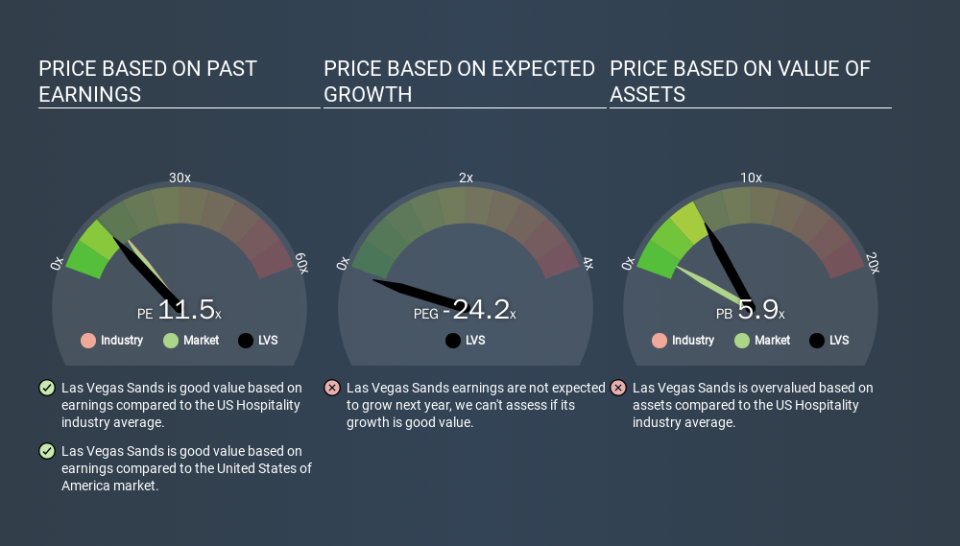A Sliding Share Price Has Us Looking At Las Vegas Sands Corp.'s (NYSE:LVS) P/E Ratio

Unfortunately for some shareholders, the Las Vegas Sands (NYSE:LVS) share price has dived 41% in the last thirty days. That drop has capped off a tough year for shareholders, with the share price down 32% in that time.
All else being equal, a share price drop should make a stock more attractive to potential investors. In the long term, share prices tend to follow earnings per share, but in the short term prices bounce around in response to short term factors (which are not always obvious). The implication here is that long term investors have an opportunity when expectations of a company are too low. One way to gauge market expectations of a stock is to look at its Price to Earnings Ratio (PE Ratio). Investors have optimistic expectations of companies with higher P/E ratios, compared to companies with lower P/E ratios.
Check out our latest analysis for Las Vegas Sands
How Does Las Vegas Sands's P/E Ratio Compare To Its Peers?
We can tell from its P/E ratio of 11.54 that sentiment around Las Vegas Sands isn't particularly high. The image below shows that Las Vegas Sands has a lower P/E than the average (13.2) P/E for companies in the hospitality industry.
Its relatively low P/E ratio indicates that Las Vegas Sands shareholders think it will struggle to do as well as other companies in its industry classification. Since the market seems unimpressed with Las Vegas Sands, it's quite possible it could surprise on the upside. It is arguably worth checking if insiders are buying shares, because that might imply they believe the stock is undervalued.
How Growth Rates Impact P/E Ratios
Earnings growth rates have a big influence on P/E ratios. Earnings growth means that in the future the 'E' will be higher. That means unless the share price increases, the P/E will reduce in a few years. A lower P/E should indicate the stock is cheap relative to others -- and that may attract buyers.
Most would be impressed by Las Vegas Sands earnings growth of 14% in the last year. And its annual EPS growth rate over 3 years is 18%. So one might expect an above average P/E ratio.
A Limitation: P/E Ratios Ignore Debt and Cash In The Bank
Don't forget that the P/E ratio considers market capitalization. So it won't reflect the advantage of cash, or disadvantage of debt. In theory, a company can lower its future P/E ratio by using cash or debt to invest in growth.
Such expenditure might be good or bad, in the long term, but the point here is that the balance sheet is not reflected by this ratio.
How Does Las Vegas Sands's Debt Impact Its P/E Ratio?
Net debt is 27% of Las Vegas Sands's market cap. While that's enough to warrant consideration, it doesn't really concern us.
The Verdict On Las Vegas Sands's P/E Ratio
Las Vegas Sands trades on a P/E ratio of 11.5, which is below the US market average of 12.7. The company does have a little debt, and EPS growth was good last year. The low P/E ratio suggests current market expectations are muted, implying these levels of growth will not continue. What can be absolutely certain is that the market has become significantly less optimistic about Las Vegas Sands over the last month, with the P/E ratio falling from 19.5 back then to 11.5 today. For those who prefer to invest with the flow of momentum, that might be a bad sign, but for a contrarian, it may signal opportunity.
Investors have an opportunity when market expectations about a stock are wrong. If it is underestimating a company, investors can make money by buying and holding the shares until the market corrects itself. So this free visualization of the analyst consensus on future earnings could help you make the right decision about whether to buy, sell, or hold.
You might be able to find a better buy than Las Vegas Sands. If you want a selection of possible winners, check out this free list of interesting companies that trade on a P/E below 20 (but have proven they can grow earnings).
If you spot an error that warrants correction, please contact the editor at editorial-team@simplywallst.com. This article by Simply Wall St is general in nature. It does not constitute a recommendation to buy or sell any stock, and does not take account of your objectives, or your financial situation. Simply Wall St has no position in the stocks mentioned.
We aim to bring you long-term focused research analysis driven by fundamental data. Note that our analysis may not factor in the latest price-sensitive company announcements or qualitative material. Thank you for reading.

